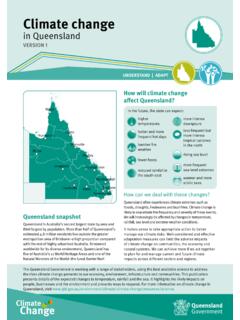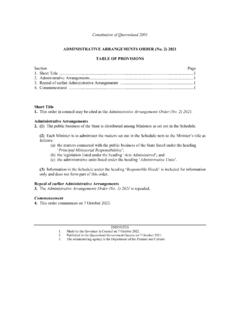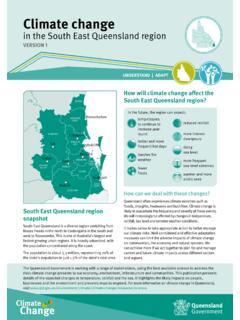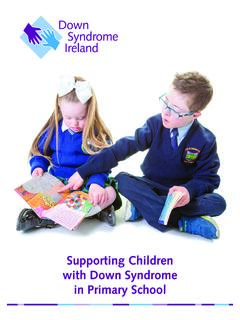Transcription of Supporting People with Vulnerabilities Framework
1 People with Vulnerabilities in disasters A Framework for an effective local response AUGUST 2016 People with Vulnerabilities in disasters: A Framework for an effective local response Page 1 of 10 Introduction Everyone faces a degree of risk when a community is impacted by a natural disaster or emergency. Protective factors, for example, strong family and social connections, enable many People in a community to be better prepared and able to adapt to the impact of a disaster. However, such factors may be limited in an individual or a community s daily life, resulting in vulnerability to higher levels of risk, injury or loss , or severe or longer term impacts than others.
2 Individuals, families and specific population groups susceptible to vulnerability factors and low levels of resilience, can require more targeted support to remain safe and to prepare for, respond to, and recover from, disaster events. People with Vulnerabilities in disasters A Framework for an effective local response (the Framework ) has been developed to help minimise the impact of disasters and emergencies1 in Queensland. The Framework outlines a state-wide approach to assist local governments and communities identify People who are or who may be highly susceptible to the impact of disasters and plan activities to mitigate or increase their resilience and/or recovery. The Framework aims to provide an approach for identifying those who may be vulnerable in a disaster and aims to inform the development of engagement strategies for vulnerable People in local communities.
3 Purpose The aim of the Framework is to reduce the impact of disasters on People with Vulnerabilities , or People who may become vulnerable2, and contribute to building resilient communities. The Framework provides a common definition that outlines the target group along with factors to consider when undertaking collaborative work to identify and engage with People who are or may be vulnerable. The Framework is intended to be of most value for the development of local plans for identifying and engaging with People with Vulnerabilities in disaster events, and the stakeholders who know them and/or provide services to them. The Framework will: assist local disaster management stakeholders to identify and engage with People who are vulnerable, or who may become vulnerable in disasters; enhance existing disaster management arrangements and planning to more effectively support People with Vulnerabilities ; and inform and drive actions and initiatives to improve preparedness and planning for People with Vulnerabilities .
4 Background The Review of cyclone and storm sheltering arrangements Report 3: 2014-15 (Inspector General Emergency Management 2015) identified the lack of a consistent approach in Queensland in relation to People with Vulnerabilities and disaster management. The report noted: roles and responsibilities in disaster management arrangements can be ambiguous local governments would benefit from assistance and resources to work with local communities 1 Disasters and emergencies are used together and interchangeably in this paper to capture all types of hazards and all phases of disaster management (before, during and after). For example, People may need to evacuate for safety in a potential weather event, but not experience a disaster due to a change in the weather event.
5 2 People with Vulnerabilities or People who may become vulnerable will be referred to as People with Vulnerabilities . People with Vulnerabilities in disasters: A Framework for an effective local response Page 2 of 10 the need to improve consistent, integrated messaging across disaster management stakeholders the need for accessible, risk based information in plain language the need for more collaborative community education greater coordination across stakeholders is required. Recommendation 3 of the report proposes A state-wide strategy, including a common definition, is developed for identifying and engaging vulnerable People in emergencies. The Department of Communities, Child Safety and Disability Services has prepared the Framework as the state-wide strategy to identify and engage with People with Vulnerabilities .
6 The development of the Framework has been informed by evidence from literature review, state-wide survey and a national jurisdictional scan. It was developed in consultation with key stakeholders from state government, local government and community agencies. The information contributed to the key elements of the Framework . Other relevant reviews Several other reviews and inquiries into past disaster event responses have also provided direction to the Framework , including: Recommendations in the Queensland Floods Commission of Inquiry Final Report 2012, which highlighted the need for local councils to identify and work with organisations that provide services to vulnerable People to support best practice planning and evacuation activities (Queensland Flood Commission of Inquiry 2012).
7 The Brisbane City Council Flood Response Review 2011, which noted the need for greater awareness of vulnerable target populations. It also highlighted the need to manage special arrangements for those for whom public sheltering is not suitable oxygen dependent individuals (Brisbane City Council 2011) The Victorian Bushfires Royal Commission 2009, included a key recommendation for the State to establish mechanisms that would help local councils to undertake planning that adapts to individual communities. Planning in this way would assist with identifying evacuation and sheltering options by helping to identify where vulnerable populations are located (Parliament of Victoria 2010).
8 Context The Framework aligns with and complements existing national and state policies, frameworks, manuals and guidelines responsible for components of disaster management. The Framework represents a proactive Queensland initiative to begin to address issues identified through the national work of the Vulnerable Sections of Society (an emergency management perspective) report endorsed in 2015 by the Australia-New Zealand Emergency Management Committee (ANZEMC). The Framework also aligns with national and Queensland Standards and Guidelines as identified in these links: National emergency management: Queensland emergency management: People with Vulnerabilities in disasters: A Framework for an effective local response Page 3 of 10 Vulnerability in disasters and emergencies Individuals and communities can potentially face and experience a greater risk of loss , injury, illness and death during disasters.
9 People may have impaired mobility, diminished sensory awareness, multiple chronic health conditions, and/or social and economic limitations one or more of these characteristics could reduce their ability to prepare for, respond to, and adapt during disasters or emergencies. A disaster can also disrupt vital support systems People with Vulnerabilities may rely on. For example, for some older persons and People with disabilities, independent living is made possible only with continuous supply of utilities and electricity, help from friends, family and in-home services that provide meals, home-based care and help with the activities of daily living. These vital services may be unavailable due to a disaster, resulting in increased susceptibility to the impact of the disaster.
10 People with low or no pre-existing risk factors can also become vulnerable to severe disaster impact living or travelling in areas of close proximity to the event, People in high risk geographic locations who experience language or communication barriers to accessing information about identified local hazards ( tourists or itinerant workers). In other words, a person s level of vulnerability to a disaster impact is not determined by a single indicator. A number of factors, including protective factors, must be taken into consideration before determining the vulnerability of a person in relation to the disaster rather than being a vulnerable person within society. A common understanding of vulnerability can also support and enhance risk assessment and risk treatment in relation to potential hazards, local planning and responses.












